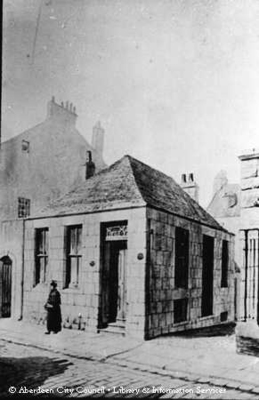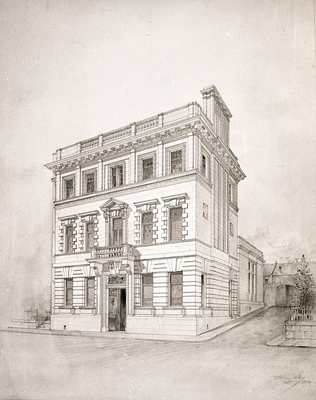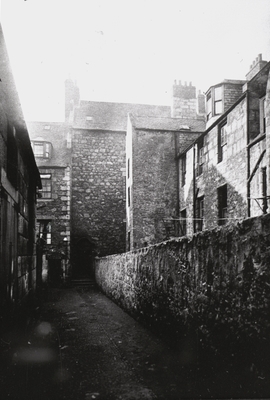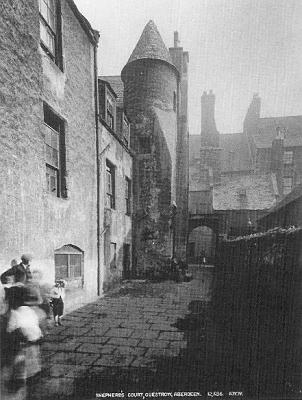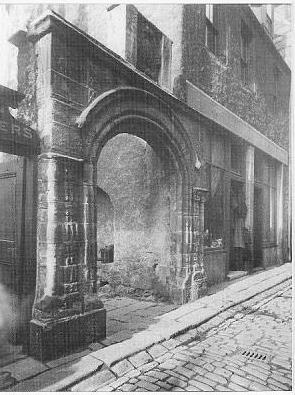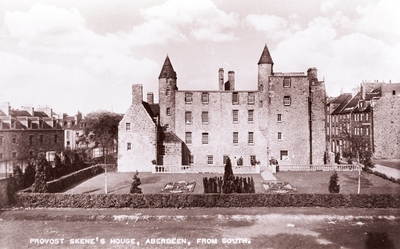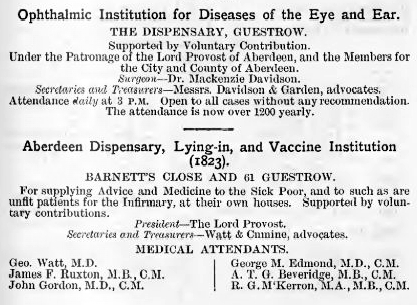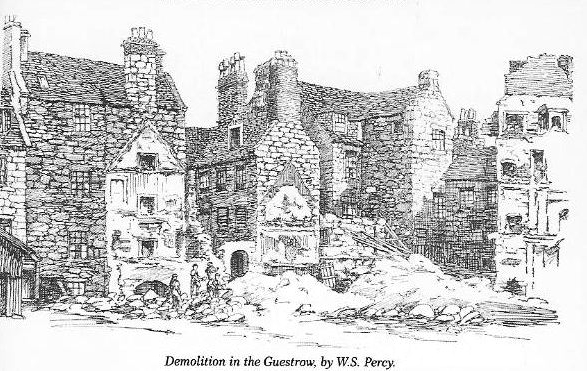A Wee Walkie up the Gushie
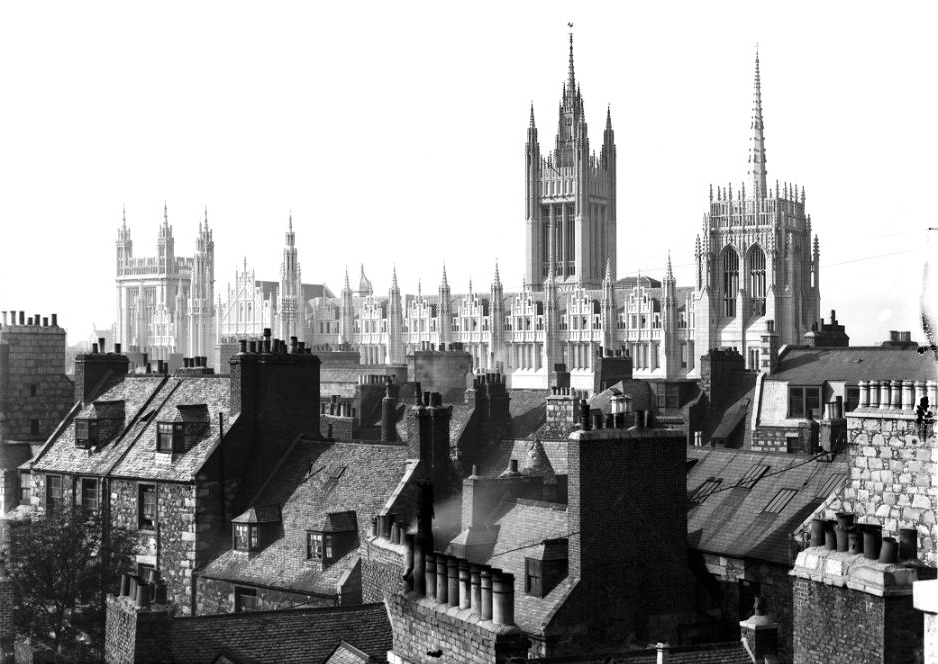
Numbering in the Guestrow does not accurately relate to individual Buildings or the Pends or Courts associated with them. Directories & Books are also confusing, giving contradicting Numbers.
OS Map of the South End of the Guestrow c.1866 to Milners Court & Ragg’s Lane
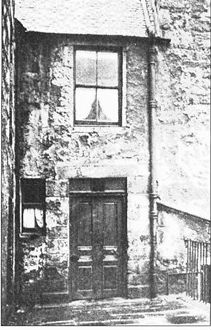
First on the West Side is a Public House with a wide front Pavement on the Corner of the Guestrow and the Netherkirkgate opposite Union Lane.
No.1 Public House – unnamed on Westside
G Clark Bookseller 2 Guestrow (East Side), Miss Bruce, (Music Teacher) 2 Guestrow No.3 Next on left a Private Property? – steps outward to narrow the pavement at –
No.5 Next on left the 2nd Public House – unnamed (Mrs Robertson Innkeeper No.3 Guestrow –1895 Directory). No.5 Guestrow, William Smith, Tailor
No.13 what was the New Inn possibly 3-Storeys & Attics with its own rear Garden adjacent to No.15 which certainly had a Gated Archway.
Mrs Robertson, New Inn & Lodgings.
No.15 Next on the left a Gated or Arched side Entrance Lane with 9 Trees on the right leading to the New Inn Garden on the left and a Property at the extreme end, with an adjacent cast-iron balustraded Staircase leading down to a lower Property Entrance on the Right. Referred to as St Anne’s Court; the birthplace of Archibald Simpson (inset), now famed Aberdeen Architect, born (lame in his left arm) on 4th May 1790, as the 5th son and last of 9 children of William Simpson (1740-1804), a Clothier at Broadgate, and his wife Barbara Dauney (c.1750 – 1801), the daughter of a Presbyterian Minister. The Family House (inset) is thought to have been built by his uncle William Dauney, who was a Master Mason – note the change in Floor level with the house adjacent which has the balustraded downward Steps. This House was later demolished in 1930. Simpson attended Aberdeen Grammar School as a contemporary of Byron, who lived nearby in the Broadgate. At age 13 he entered Marischal College but left after a year, on the death of his father, to work in the Office of James Massie, a Builder/Architect (who had a Yard at Castlehill and a House in Union Street), between 1804-10 having been duly influenced by his uncle. Simpson was of slight build and ‘shy & retiring’ in character but was said to have been a man of ‘strong & eccentric character’. He was remembered as ‘a little, active man, always to be seen carrying plans under his arm’. He loved music and played the violin. Its walled entrance just beyond the New Inn is the wrought Iron Gate on the extreme left of A J Murray’s c.1898 Artistic Sketches shown below.
James Grant & Co, Jeweller, 16 Guestrow 1833
No.16 Mrs Simpson, Lodgings
No.17 – Aberdeen Savings Bank – was formerly Baillie Alexander Galen’s House. Here the 1st Aberdeen National Security Savings Bank at No.17 Guestrow and perhaps Galen’s Court is No.19 as suggested by the larger numeral on the right of the Doorway. The Building is isolated between the lesser Arch of Simpsons Home No.15 on the left with the New Inn beyond and No.19 Galen’s Court on the right. A modest and unassuming structure for the frugal Aberdonians to deposit their spare Bawbees & Mecks. The larger Shepherd’s Court Arch column is just included by the Artist. Galen’s Court is indeed No.19 before the Arch and is thus numerically correct. (Artist A J Murray numbered it 77-79 – his licence)
The Savings Bank opened Thursday to Saturday and from 9-am till 10-am & in the Evening from 7-pm till 8-pm. Savings Bank above was Founded in 1815 and had conducted its Business in these modestly small Offices on the Guestrow until 1st July 1858, “for receiving such small sums as may be saved from the earnings of Tradesmen, Mechanics, Labourers, Servants etc”.

As the Bank became more successful, they moved from its Premises in the Guestrow to a new Building in Exchange Street. (inset) The ground had been Feued from the Scottish North-Eastern Railway Company in January 1857 and this Building erected at a cost of around £2,800. As the Population of the City moved further West away from the Medieval City Centre, the Directors felt that a change of Site was desirable and, having acquired Land in Union Terrace, a new, much larger Office was opened in 1896.
This 3-Storey illustration, by the Architect William Kelly in 1894, shows the building that was to be constructed at the junction of Union Terrace & Diamond Street at a cost of £11,000. The Design is of Renaissance style, with the central Entrance leading to an inner Porch lined with red & grey Granite, then a short flight of steps led to the main Telling Office. This opulent Office had a deeply Panelled Ceiling & Dome partially filled with painted & decorated glass. Coats of Arms of the City & Lord Provosts were also displayed. The Counter & Desks were made of mahogany & oak with wrought iron and wrought copper Grills. In the 1960s, a large extension was Built on an adjacent Site and, in 1983, the Bank became part of the Trustees Savings Bank in Scotland and in 1999 became part of Lloyds TSB.
No. 19 – Galen’s Court – James & John Hay Jr: the 2-brothers took over their father John Hay Sr’s Business of Hay & Lyall in 1847. In Aberdeen censuses, James Hay can be found in 1851 at Galens Court, 19 Guestrow as a Carver & Gilder, age 29, with his wife Mary & 2 daughters. John Hay Jr can be found in successive censuses as a Carver & Gilder, with his wife Ann & children, in 1861, age 35, living at Galens Court, 19 Guestrow, employing 9 men & 3 boys, in 1871 untraced, in 1881 at 9 Rotunda Place and in 1891 at 6 Polmuir Road. At one time or another, premises at 19 Guestrow were described as a Home & Workshop.
Later it has a Gated Entrance with a downward sloping cobbled Court way leading to steps to a Private Property on the right with a long dark Pend on the left with an obscure sign over it with a name underneath, leading to 4 steps down to a Walled Garden with a Fountain beyond. The long 6ft rubble Wall separates this Court from that of the adjacent Mrs Robertson’s Inn & Lodgings Property in Shepherd’s Court. On the opposite side is the flanking Ashlar Wall of the Savings Bank
No.21 Shepherds Court – Arched entrance with Crest above to rubble-built 3-Storey Structures and Attics with Dormer Windows, Mrs Robertson’s Inn & Lodgings with a long Court leading to a Drying Area and a narrow 3-Storey Spur Wing which reaches close to the dividing Wall. The 2-Houses there were owned by Andrew Thomson, Sheriff Depute & Advocate in the 17thC. It was also the home of Provost Bannerman, Sir Alexander Bannerman of Elsick who was created a Baronet of Nova Scotia by Charles II in 1682 (hence notation No.34 on Milnes 1789 Map of ‘Baronett’s Close‘). His youngest son Patrick (Burgess of Guild & Aberdeen Merchant) supported the cause of the Stuart Monarchs and rose in support of the old Pretender in 1715. He too was the Provost of Aberdeen. He presented a loyal address from the Town to the intended James VIII at Feteresso, welcoming him back to his Ancient Kingdom of Scotland. James delighted with this demonstration of Loyalty, promptly Knighted Provost Patrick Bannerman. He was arrested by the Hanoverians after the failure of the raiding and was sent as a Prisoner to Carlisle to await Execution but managed to escape to France.
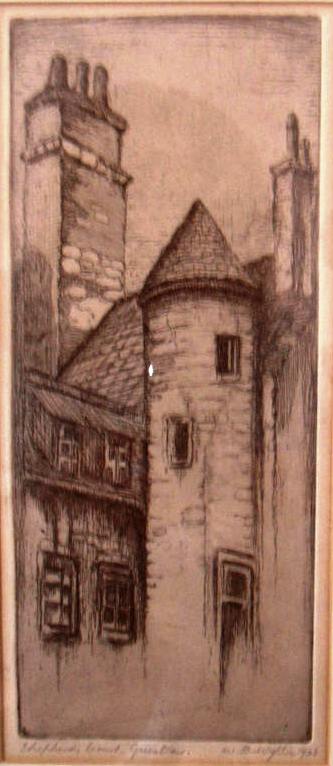
Shepherds Court is entered by the misnomer of Galen’s Arch or more correctly Thomson’s Arch. This photograph shows it is walled to the right and clearly shows the possibly failing Staircase Turret and former North Entrance which may have been, Squared-off & Buttressed to prevent its collapse. The Archway with its central Initialled Crest opens onto the Guestrow. Several Civic Chiefs resided along this Street: Provost Leslie, Provost Alexander Jaffray & Provost Bannerman, the Jacobite of 1715. The latter lived in the House known as No.1 Shepherd’s Court; earlier occupants were Sheriff-Depute Andrew Thomson, Advocate and his wife Agnes Divie in 1673, whose Initials appear on a Crest over the Gateway, originally leading to the Court. However, the Gateway itself is at least early 17thC, similar in date to the old House, which old photographs show to have been a semi-castellated Building (probably because of the flush fronted Dormer windows) consisting of a rectangular block having attached at one Corner a strong round Conical-roofed Tower with Entrance door & window. Sheriff-Depute Thomson’s House had possessed the interesting qualities of sturdy Scots Domestic Architecture at its best. Unfortunately, when the Guestrow Slum Properties were demolished, few discerning eyes could distinguish good Medieval Buildings from relatively Slum Squalor. Or indeed made any record of what was ‘Knocket Doon’. The roof of the Savings Bank is visible above the long rubble Wall.
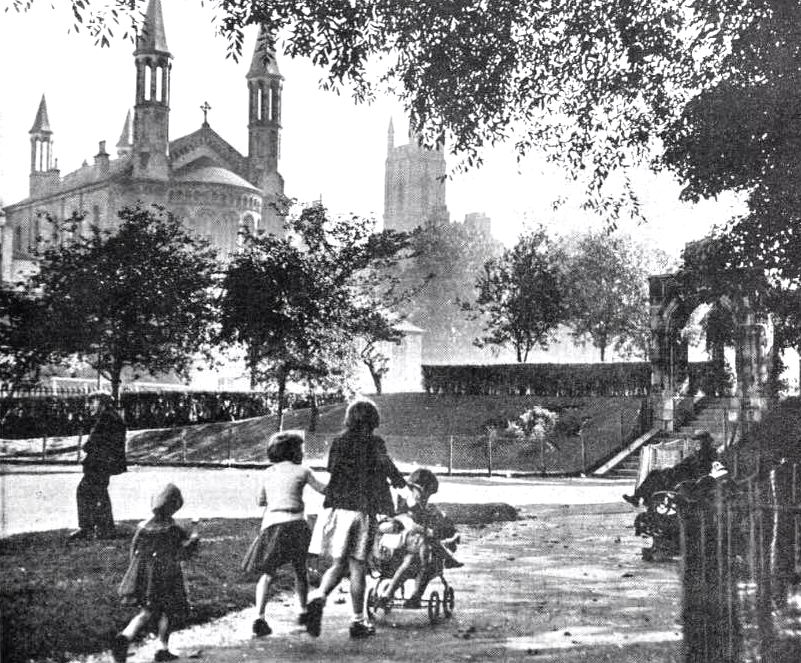
Alexander Thomson, Advocate in Aberdeen, 1718, was the son of Andrew Thomson in Peterculter, This Alexander Thomson, purchased, in 1743, the Estate of Banchory, in the Parish of Banchory Devenick, Kincardineshire; He executed a Deed of Entail of his Estates, giving, as a reason for so doing, that he had observed that the successors of so many of his friends & relatives had ”squandered away their Estates, and spent the same in a foolish, profuse, idle way.” It was in his House, in the Guestrow, Aberdeen, later the Victoria Lodging House, that HRH the Duke of Cumberland made himself much at home for 6 weeks, in 1746. Thomson died in 1773, aged 81, having married, in 1727 Katherine, the daughter of Sir George Skene of Rubislaw, she survived him and died in 1776.
Shepherds Court, 21 Guestrow, Archway
This commemorates a Grand Archway and a Date Stone from a 17thC House. The Archway was erected in 1637 by Andrew Thomson, Advocate & Sheriff-Depute in Aberdeen, as the ‘Gateway’ to his finely castellated House in Guestrow. His initials and those of his wife, Agnes Divie, are on the central Crest panel built above the Arch. On the Demolition of the Properties in the Guestrow, in 1931, the Archway was rebuilt over steps to a Southbound Glade Arbor/Tunnel Walkway Entrance Steps in Union Terrace Gardens, from where it was taken in 1970 and re-erected at Provost Skene’s House near Flourmill Lane. To the left, there is a Trader’s Yard Entrance to Galen’s Court with a Proprietor’s name ending in L and the Trade truncated to ‘ders’ (Hay & Lyall – Carvers & Gilders?). Note the Medieval V-flagstone Gutterway to the Guestrow Street.

OS Map of the North End of the Guestrow c.1866
from Milner’s Court to Upperkirkgate
No.23 Webster’s Court, Guestrow? (from Directories but this may be the Arched Court beyond)
No.25 Milner’s Court, Guestrow, (just South of Ragg’s Lane) – long narrow Court with an Arch and a further Pend leading to sloped Gardens and directly to Flourmill Lane.
Mrs George Daniel
A Findlay, Shoemaker, ft.
D Riddle, Watchmaker, h.

No.27 Public House Pend to Thornton’s Place, (Robert Fleming, 27 Guestrow, Spirit Dealer PH) a busy little rectangular Court with flaring Balustraded Steps leading up to a large House and a with yet a further Pend to the right, leading towards No.29 Niven Court
John Elrick, Mason, 8 Thornton Place
David Courage, Labourer 3 Thornton Place c.1881
3 James Tytler, Porter, House of Refuge – Victoria Lodging
4 James Walker, Watch & Clockmaker
8 Alexander Hay, Japanner
9 James Reid. Wright
10 Alexander Hay, Japanner
11 John Calder
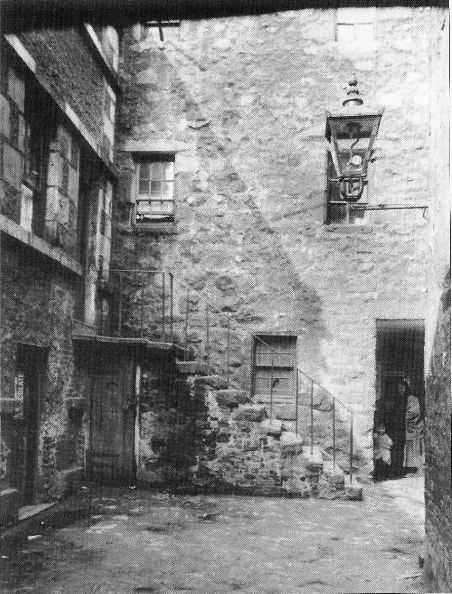
No.29 Niven’s Court, a Private House Pend on the Guestrow with 2 further Pends leading through to Thornton’s Court & Thornton Place. Here Niven Court’s external 1st Floor Balustraded Staircase is photographed from its 2nd Pend (which led through from) Thornton’s Court (when coming from No.4 Flourmill Lane) and looking East towards its 1st Pend (where the woman & child peer suspiciously at the camera) and leading outward to No.27
Guestrow, Websters Court also No.27 the Guestrow (but with an entry off Thornton’s Court)
Thornton’s Court, also No.27 Guestrow (beyond Niven’s Court led through to No.4 Flourmill Lane which itself ran from Quaker’s Court to the Netherkirgate). This complicated description is best read in conjunction with the detailed area Maps; it certainly conveys the old Medieval approach of Backland (Backies) Development to provide necessary housing accommodation for income, friends or relatives in that Era. Hence a deal of confusion over Street numbers.
No.32 West Court, Guestrow (1835 Directory), Alexander Davidson, Vitner, 32 Guestrow PH
Peter Grant, Druggist, West Court, 32 Guestrow 1833
No.34 Guestrow, Alexander Paterson, Spirit Dealer – PH
No.37 Guestrow – James Reid, Wright.
No.41 Mitchell’s Court, a T-shaped Court behind a Public House Pend (Charles Mitchell, 41 Guestrow, Spirit Dealer)
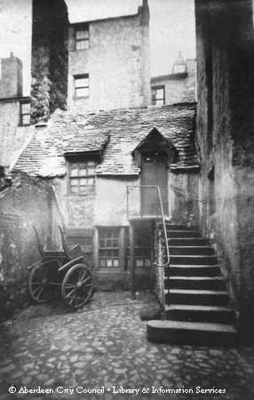
This is very likely the external Staircase to the upper Dwelling which is built onto the rear of the Public House which in turn is fronting onto the Guestrow. We are looking North in the T-shaped Mitchell’s Court which appears to be the abode of a Trader & Hand Carter – behind the Cart is an open window shutter and its neighbouring window is half-concealed against the external Staircase. The viewpoint is looking into the spur stalk of an inverted ‘T’. Gutterless red clay-tiled Roofs gave much welcome colour and were common in the Guestrow as were the dour rough Granite rubble walls. The paler picture is also a Photograph that has been ‘touched-up’ by the developer perhaps to give a snow effect hence the surviving radius corner popular in those early days of Cameras. It now highlights a diagonal Handrail in the corner by the 1st Floor Door and the Pub Wall. This Property, therefore, fronted onto Duthies Court
Mrs Cormack, Provisions Merchant 41 Guestrow – Mitchell’s Court – a Pend South of – Duthie’s Court,
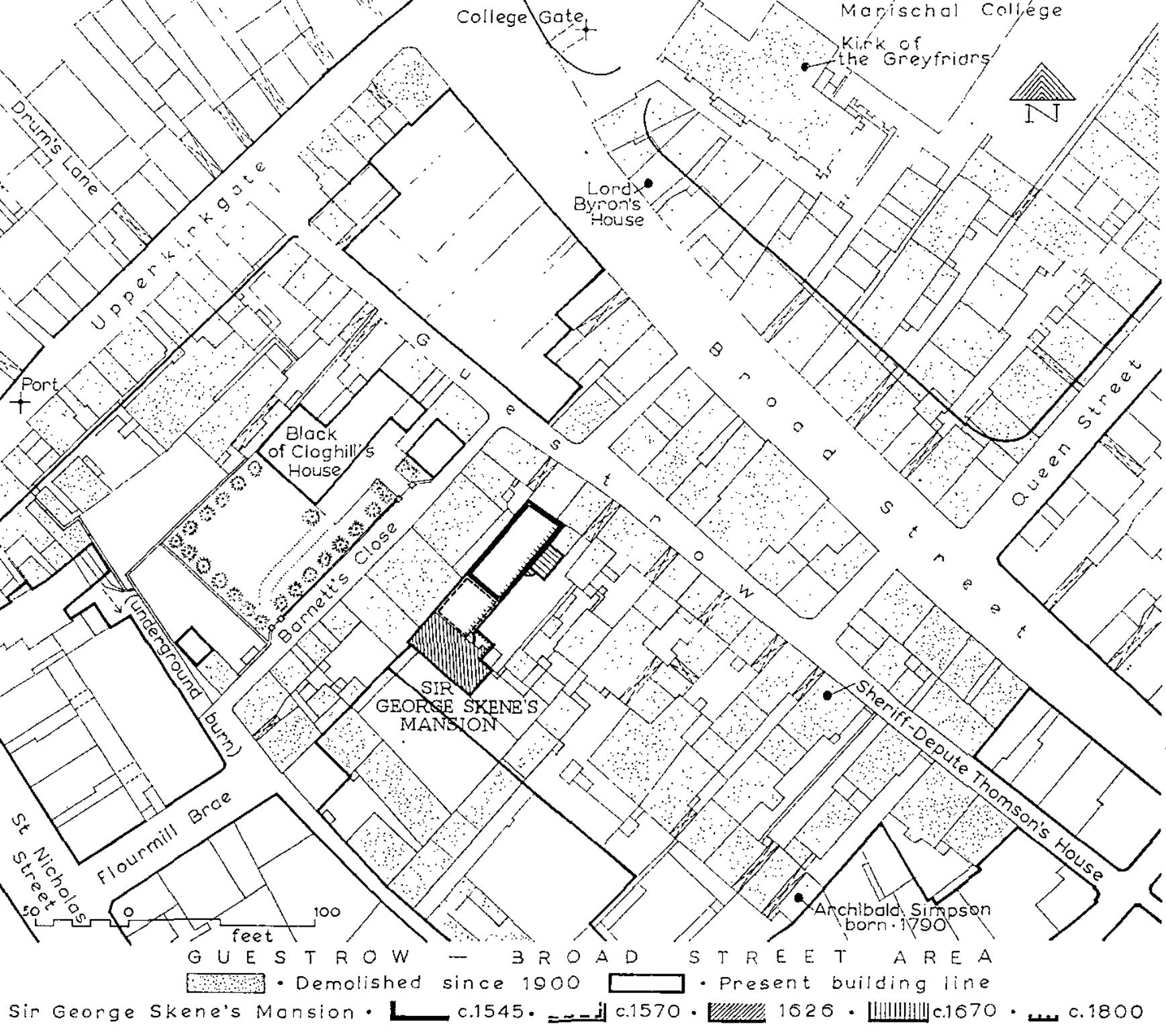
This Map shows Simpson’s House at No.15 Guestrow (St Annes Close) and the picture of his house is accurate with downward steps to the adjacent Property and the OS Map shows 9 Trees along it. No.17 is Alexander Galen’s House which became the Savings Bank and No.19 is Galen’s Court where Hay & Lyall (Carvers & Gilders) lived and had a Workshop, No.21 is Shepherds Court with Thomson’s House along with an Inn & Lodgings beyond, Next is No.23 Milner’s Court which is just south of Raggs Lane
Peter Grant, Wright, Duthies Court 35? Guestrow 1833
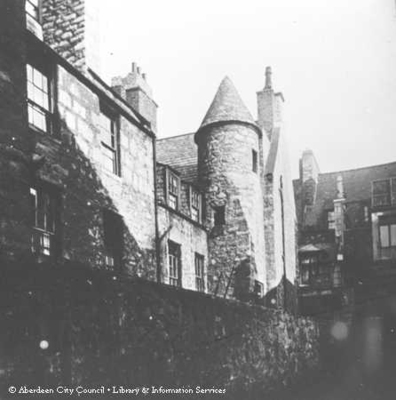
Click to Enlarge
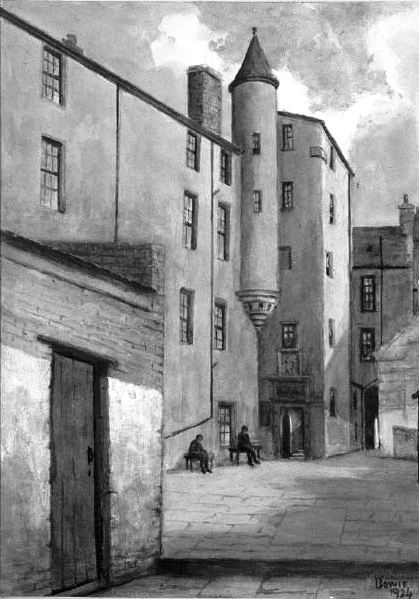

No.45 Guestrow – Private House Pend to Duthie Court & Victoria Lodging House (Provost Skene’s Mansion) –
Provost Skene’s House built from rough Granite Blocks and dressed Freestone. This Townhouse dates back to 1545. It had several Owners before Sir George Skene in 1669. He was Provost between 1676 & 1685, receiving a Knighthood in 1681. He undertook a major reconstruction of the Property, adding Turrets and the strange Flat Roof. The House boasts a Ceiling dating from the early 1600s which shows Scenes from the Bible, in this case, the Crucifixion. Also known as ‘Cumberland’s House‘ although the ‘Butcher of Culloden’ only requisitioned it for 6-weeks as he moved North. lt was subsequently used as the Victoria Lodging House for 75-homeless men both before and after the new Model Home was built on East North Street in 1897.
Sir George Skene’s House
Of the reputedly-haunted Guestrow (from Ghaist-Raw), the main remnant is the beautifully-restored 16thC George Skene’s House (Provost), later referred to as Cumberland’s Lodging (post-Victoria Lodging) following its requisition by the infamous Duke of Cumberland on his way to Culloden Moor in 1746. Once used as the Victoria Lodging House (Instituted 1840 and still in use in as a Municipal Lodging House in 1931). This most striking & accessible of the Old Houses still left, was in Duthie’s Court at No.45 the Guestrow. It was used as a House of Refuge and was kept in substantially good order and is now readily shown to Visitors. It was once the home of well-placed people, and the Duke of Cumberland Lodged here when he was North in “The Butcher” of Culloden business. He and his Officers had free Quarters here and were Royally entertained by the City Fathers; yet on departing, they packed up everything on which they could lay hands in the way of Plate, Linen and other household-providing. The Owners got no payment or other compensation. His Troops were also Billeted in a substantial fortification which was then an unoccupied Robert Gordon’s Hospital, built 1739 to the design of William Adam, father of the Adam Brothers, Robert & James. They are commemorated by the Adelphi Court, the name of which refers to ‘Dolphins‘ a Classical Symbol of Brotherhood.
Snow-covered Duthie’s Court looking west to the Lumsden Pavilion Entrance – the West Wing Extension to Skene’s House.
Duthie’s Court looking West from No.45 Guestrow with the lean-to on the left; the Duthie Family (Advocates) once owned Skene’s House. The Pavilion Porch was added about the end of the 18thC with the purpose of enclosing the dog-leg Forestair (originally External) leading to 1st-Floor level.
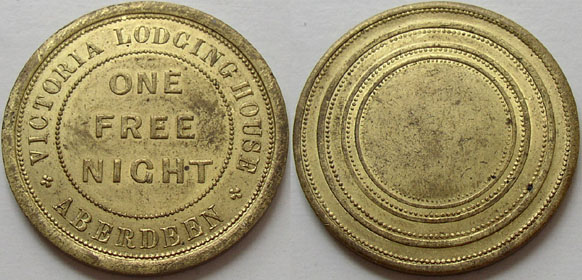
Och – its jist ane free nicht’s ludgin’ min – A Pro Bono Token issued by the Council or otherwise the Overnight stay charge for a male Lodger may have been 4d per night
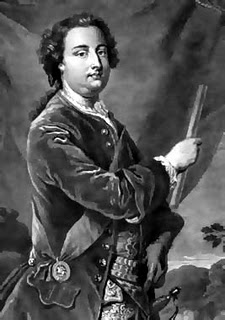
The ‘Butcher’ – Duke of Cumberland
By the 16thC, the Guestrow was already somewhat built up – each Tenement consisted of a House fronting, and parallel to, the Street, through which a Pend gave access to an inner Court, one side of which was occupied by a building at right angles to the Street House. The back of the Court might be closed by another House. We know from Parson Gordon (1661) that in his time the houses were of stone & lime, slate-roofed, mostly 3 or 4-Storeys high, some higher. Streets were carefully paved and House frontages were adorned by Timber Galleries & Forestairs. Adjoining most dwellings were Gardens & Orchards with so many Trees that the whole Town would seem to be set down in a Woodland. Throughout the centuries, the now-demolished houses of the Guestrow were the Mansions of famous personages, including Sir George Skene, the ‘Bloody’ Duke of Cumberland, & Major James Wolfe (later the Victor of Quebec) who had occupied the re-named ‘Cumberland’ House (formerly Skene’s).
W S Percy’s excellent detailed Sketch of Skenes House, Lumsden Wing & Outhouses associated with the Sloping Backlands drawn c.1933 when Demolition of the Guestrow was well underway. Looking East the use to what these Pantiles & Skylight Pantiled Roofed Outhouses were employed is left to the imagination but my be a combination of Accommodation, Wash-houses, Artisan Workshops or even Ashpit Privies.
OS Map of Guestrow 1867 from Raggs Lane to Upperkirkgate
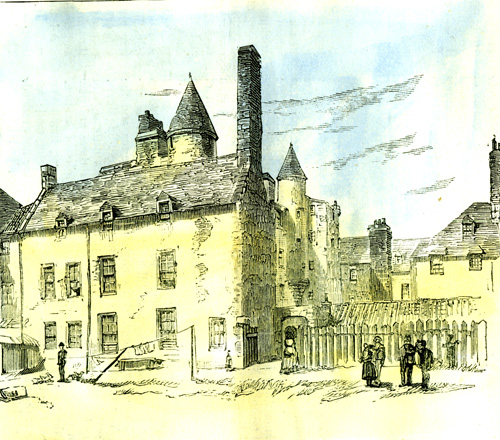
Mathew Lumsden (or Matthew), Baillie of Aberdeen, married Elisabeth Aberdour, Purchased in 1622 a House in Guestrow. Lumsden added a 2-Storey & Attic Gabled section to the South-west side. His Coat-of-Arms, dated 1626 is clearly visible in one of the Dormer Gables. The house, is now known as “Provost Skene’s House”, but Lumsden owned it until his death, there is a Coat of Arms in the House which resembles that of Lumsden, he was a Covenanter [the National Covenant was drawn up in 1638, defending Independence of Scottish (Presbyterian) Church from English (Anglican) Impositions, can be seen as part of build-up to English Civil War (1642-51)], held hostage 1639 by Lord Aboyne, died for the cause 1644 at Battle of Justice Mills. This West Wing view is towards Duthie’s Court rear Entrance Archway beyond the Drying Green.
Robert Cobban & Co, Printers, Duthie’s Court, 35- Guestrow (c.1827)
No.45 Guestrow – Instituted 1840 as a House of Refuge & Industry. Mrs M A Young, Matron
Here the intervening odd numbers 47, 49 & 51 may be related to 3-Public Houses fronting onto the Guestrow Pavement.
No.51 George Mckay, Vitner, Public House Guestrow home 49.
Quakers Court, No.53 or 55 Guestrow (entered by a Pend between 2-Public Houses) and opposite Blairton Lane led to the then Friends Meeting House, Episcopalian Chapel & the foreboding Granite Sarcophagus located near Flourmill Lane. It does not appear that the Quakers had any settled Meeting-House in Aberdeen for some considerable time after they 1st made their appearance in the City in 1662. Perhaps this was largely owing to the persistent Persecutions of the Period, and it is probable that for a number of years they may have met in the Houses of one or other of their own number. The 1st Meeting-House on record was situated on the West side of Guestrow, and, although it is doubtful if the Building could be readily identified, yet “Quaker’s Court,” may be regarded as affording some indication of where it stood. The Minutes of the Society in Aberdeen have been preserved, the 1st Minute Book beginning in 1672, shortly after the establishment of the Monthly Meeting. There are also Registers of Burials, Marriages, & Births from a very early date. In 1827 a new Meeting-House was Built in the Gallowgate, in a Court adjoining Mar’s Castle.
Boys’ School of Industry, in Quakers’ Court, 55–Guestrow
In 1841 a School of Industry was Established in Aberdeen by Sherriff William Watson to provide Education & Training for boys involved in Street Begging, Vagrancy & Petty Pilfering.
Quakers Court, No.53–Guestrow. (alternative number)
The Quaker Religion began in the mid-17thC with George Fox and like-minded seekers. Fox had studied the Bible in detail and had many questions about it. He tried all the Preachers & Priests he could find but none of them could help him answer these queries. He came to realise that people can have direct experience of God without an Ordained Minister as an Intermediary. Nowadays, there are Worshipping Groups all over the Country meeting each week to share Fellowship together. The Religious Society of Friends has been active in the North-East of Scotland, mainly in the City of Aberdeen, since the 1660s. Despite Persecution, which reached its height in the 1670s, numerous North-East people were attracted to the new movement, such as Robert Barclay (1648-1690), Theologian, Provost Alexander Jaffray (1614-1673) & George Keith (1638-1716). Keith was born in Aberdeenshire into a Presbyterian Family. He Graduated from the Marischal College, Aberdeen, with an MA in 1657. Keith became a Quaker in the early 1660s and was Associated with the Aberdeen Meeting House from 1663. Keith faced the Persecution that came with his Conversion due to Government attempts to enforce Religious Conformity. He was Beaten & imprisoned in the Tolbooth in 1664, Imprisoned again in 1667 for 9-months, Arrested in 1676 and Imprisoned a further 3-times between 1678 & 1680. Keith wrote many great early Works while in Prison expounding Quaker Theology. Keith married Elizabeth Johnston in 1671, also a Quaker, who bore him at least 3-daughters. They emigrated to American in 1684. –
(The present Meeting House is now in Crown Street.)
No.55 Northern Advertiser Office, Quakers Court, Guestrow
No.57 Tavern, Guestrow
No.57, Guestrow, Vernon, & Co, Brassfounders, Coppersmiths, & Plumbers
No.59 Guestrow, Mrs Thom, Spirit Dealer (PH)
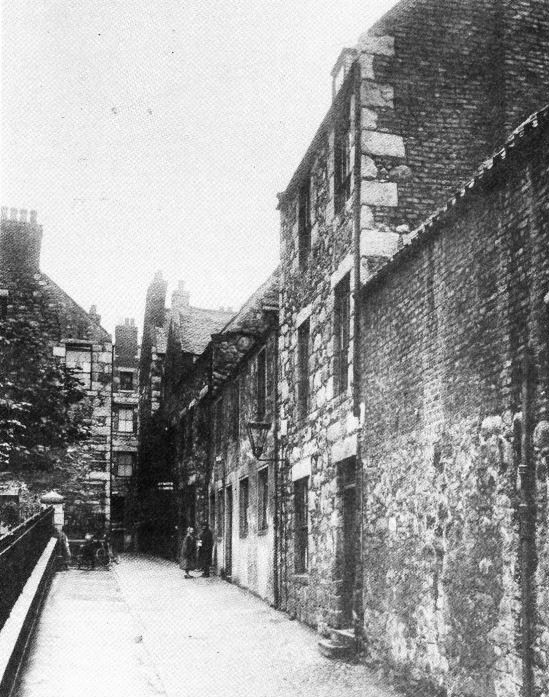
Butler’s Tavern, 6 Barnett’s Close, Vitner, Colin Campbell, c.1824.
There is on the OS Map a large Pub on the right corner of the Guestrow which also shared the Pend Entrance with another Pub at Quaker’s Court – Hence No.s 55 & 53
This narrow to wide, to narrow Close leads from the Guestrow to the wider Flourmill Brae & narrower Flourmill Lane. This image was taken looking East towards the Guestrow. On the left was the Garden Fence of Black’s of Coghill ‘s House (the Garden was originally lined all-round by Trees) which eventually became the Aberdeen Dispensary.
Barnett’s Close, (originally Mapped as Baronet’s Close) and ran from Guestrow to Flourmill Brae & Lane. The 1st Meeting Place of the Aberdeen Methodist Society was in Barnett’s Close but the exact Location is unknown.
Aberdeen Equitable Loan Company, Barnett’s Close.
John McKenzie, Blacksmith, Barnett’s Close

The Aberdeen Journal, Wednesday, 20th January 1858
Serious & Alarming Fire – Yesterday afternoon about 5-o’clock, a Fire broke out in the premises occupied by Mr Montgomery, Pawnbroker, corner of Barnett’s Close, Guestrow. The Fire originated, it is said, whilst Gas was being lighted – the flame having, according to conjecture, caught some of the Soft Goods with which the room was filled; of course, it soon spread through the Premises. The Wind was blowing strongly from the South-West at the time, and the Fire assumed a very threatening aspect from the First. The narrow Street (Guestrow) was quickly spanned by the Flames, which, but for prompt and efficient counteraction, would have found abundant & fit material, and the conflagration might have become a very extensive one, entailing fearful consequences. The Firefly Engine from the Watch-house was brought rapidly to the spot, followed soon by 4 other Engines, including that from the Barracks. A plentiful supply of Water was at hand, and the Engines being efficiently wrought – the Wind meanwhile moderating somewhat – happily, the Flames were confined nearly altogether to the Premises, some damaged being, however, done to a contiguous House. The Fire commenced in the Upper Storey of Mr Montgomery’s Premises, and the Goods, as indicated, and also the Woodwork of the House, being of a nature to feed the Flame, very soon the whole Roof fell in, and a large part of the Flooring. The House is a double one of 3-Storeys and well packed with Goods, a very small proportion of which was saved. We learn that the Property is uninsured so that the Loss must be Heavy. The Poor people who had left their clothing & effects as Pledges, it is said, take the risk; the Proprietor, however, must also be a Loser. In about 2-hrs the Flames were greatly subdued and soon afterwards all but extinguished. Praise is justly due to the Officials & Firemen; also to Lord Provost, Mr Thomson, Banker, and other Gentlemen who were promptly upon the spot, as well as Colonel Fairtlough, and the Military under Command of Captain Brown, 93rd, for their efficient assistance. The Fire was Witnessed by Crowds, who filled every adjoining Street & Approach to the burning pile; but we are glad to say there was no accident worthy of mention.
No.61, Walkers Court Guestrow
The only other House that remaining briefly in the Street, other than Skene’s House, 1st belonged in the late 18thC to the Merchant Family of Black of Cloghill in Walker’s Court approached from a Pend Entrance and leading to the later Female School of Industry a Charitable Institution, wherein Poor Girls receive Board & Education and are also taught various Branches of Industry. The Institution was Chiefly supported by the Benevolent of the City & sundry Dwelling Houses. On the 5th June 1843, Sherriff William Watson opened the Female School of Industry which occupied premises at Longacre. On the 19th May 1845, the School relocated to 61-Loch Street. The original School only having 3-Inmates re-opened in July 1847 at Shaw’s Court, a small Court known by this name Situated on the East side of the Gallowgate, as the Female School of Industry. At around 1852 it relocated again to Walker’s Court. In 1870 the crowded & closed Guestrow Site was exchanged for the superior & much larger Premise of North Lodge between West North Street and its Entrance at 167-King Street housing a 100-Girls from 7-13 yrs at age of Enrolment. The Walkers Court Building later referred to as the ‘Dispensary’, had claimed little Architectural merit, being much altered & added to during its more recent Conversion into Offices. However, it retains its walled & tree-lined Garden, grass-planted, but offering visual proof of the fact that the enclosed Gardens contributed much to the Guestrow being a desirable Residential Neighbourhood, as it undoubtedly was until over a Century ago.
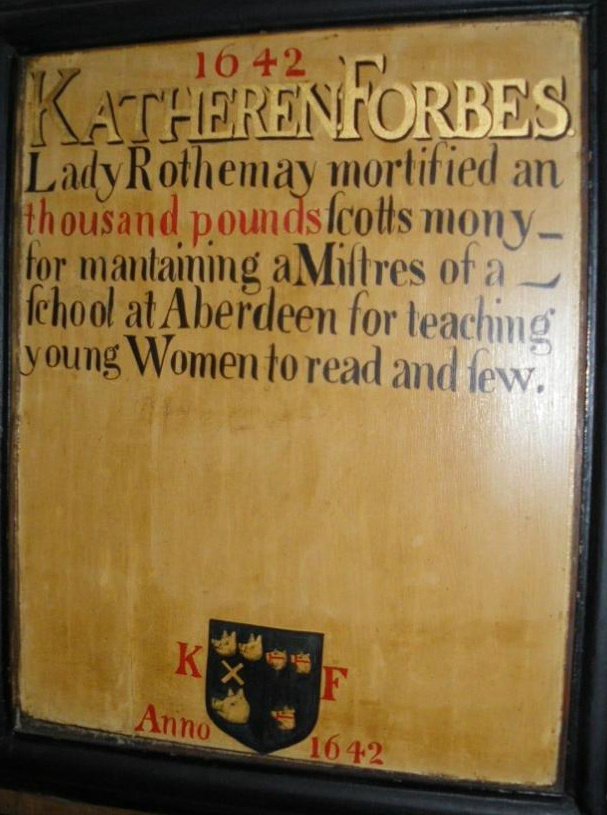
The School of Industry started in Longacre 5th June 1843, 61-Loch Street 19th May 1845, Shaw’s Court, Gallowgate, July 1847, Walkers Court, 61–Guestrow 1852, North Lodge 167–King Street 1870 to house over 100-Girls, then from Skene Square to Whitehall Road in 1881.
Lady Rothiemay (1583-1652) had a turbulent life. Katherine Forbes was the daughter of John, 8th Lord Forbes, and his 2nd wife Janet Seton. She was Educated in Aberdeen. She married William Gordon of Rothiemay in the Winter of 1603/4. The Gordon’s & their neighbours the Crichton’s were at Feud and William Gordon died after a Skirmish in 1630. The Crichton’s were ordered to pay Compensation, but later in 1630 Lady Rothiemay’s eldest son died in a suspicious Fire. Lady Rothiemay sought revenge. The Privy Council reported that she had a special hand in all the disorders & troubles in her area. She was Imprisoned in Edinburgh from 1635 until February 1637 when the King ordered her release. Once released she lived in Aberdeen at Baillie Mathew Lumsden’s House (now the West Wing of Skene’s House) and Founded Lady Rothiemay’s School for Girls (1642), in which she took a personal interest. She set up a Provision in Trust to give £1,000 Scots to maintain a Schoolmistress to teach Girls to read, write & sew. The proviso being that the said Schoolmistress must be “a Widow of good repute”. The School moved around several times, from Guestrow finally to Littlejohn Street. It was closed in 1873 when School Boards were set up to oversee Primary Education for the under 12s, following the Education Act of 1872
William Johnston, who was born in January 1762, was a Merchant & Shipowner in Aberdeen; in September 1792, he was admitted a Burgess of Guild, and shortly thereafter joined the Town Council of Aberdeen, with which he remained connected during the rest of his life; having within that Period, of about 40-yrs, filled several Offices in the Corporation, including those of Dean of Guild & City Treasurer. He was also in the Commission of the Peace for Aberdeenshire. Mr Johnston took much interest in, and bore no inconsiderable part in originating, the Aberdeen Town & County Bank, and, in addition to being one of the largest Stockholders, was a Director, from its Institution in 1825, down to the time of his death. He resided for many years in the Blacks of Coghill House in the Guestrow, later occupied as the General Dispensary, but in 1826 he purchased the Villa & Lands of Viewfield, Craigiebuckler, near Aberdeen, and in the following year took up his abode at that place, where he died 22nd February 1832. (Hence – Johnston Gardens – his former Estate)

Aberdeen Dispensary, Lying-in (Maternity), & Vaccine Institution (1823 – 61 Guestrow)
For supplying Advice & Medicine to the Sick Poor, and to such as are unfit Patients for the Infirmary, or at their own Houses. Supported by voluntary contributions the General Dispensary, gave free Medical Advice & Treatment to all that required it, as well as for Patients at Home who were too ill to attend. The Dispensary was Founded in 1781 and was Independent by 1786. In 1790 the Dispensary split into 3 separate Institutions but these combined, in 1823, to form the Aberdeen General Dispensary, Vaccine & Lying-in Institution. In 1870 the Dispensary bought 2 Houses in the Guestrow, – one to serve as a Maternity or Lying-in Unit, although qualified Midwives were not appointed to Serve until 1892.
The Lying-In Institution moved to Barnett’s Close in 1893 for those Patients whose Houses were too wretched for them to receive proper care & attention. In 1900 the Bank of Scotland Offices in Castle Street/Terrace was bought & converted into the Maternity Hospital. The National Health Service later made it redundant in 1948.
A famous Daughter of Aberdeen who has shaped Midwifery throughout the world is Maggie Myles (1892-1988) who wrote her ground-breaking book Textbook for Midwives ‘With Modern Concepts of Obstetrics & Neonatal Care‘ in 1953, the year before she retired. Maggie produced a further 9-Editions, each kept up-to-date with the latest Developments & Best Practice. The Book has been translated into many languages and is recognised as the leading international Textbook for Midwives. The Book is now in its 15th–Edition. Born in 1892 in Aberdeen the daughter of a House-painter and former Domestic Servant Maggie Myles life story is truly remarkable. Migrating to Canada soon after leaving School Maggie would rise to become the Director of Midwifery Education in Philadelphia & Detroit before returning to Scotland in 1939 to be Midwifery Tutor at Simpson Memorial Maternity Pavilion in Edinburgh.
No.63 Guestrow, Mrs Smith, Spirit Dealer (PH)
No.65 Stewart’s Place, Guestrow – Pend leading to small Court – Pavement narrows again here and opposite this was –
Red Lion Inn Court – A narrow Court containing Dwelling Houses, extending from the Red Lion Inn, 77–Broad Street to the Guestrow.
Jane Bowie, Cook Shop & Registered Office, 66-Guestrow (East Side)
Burn’s Tavern 68–Guestrow (East Side)
Ramage Court – A narrow Court with Dwelling Houses extending from 83-Broad Street to the Guestrow.
No.65 Stewart Place, Guestrow, Shooting Gallery – Royal Shooting Saloon, Quoit & Cricket Ground, George Stewart, Manager
No.67–Guestrow (Samuel Orr, Spirit Dealer – PH)
No.71–Ramsay’s Court, Guestrow
(Some 8-Public Houses were in the Guestrow)
Guestrow, West of Broad Street – Demolition 1930–1932
The word “Guestrow’ may derive from ‘Ghaist Raw’ because of the Street’s proximity to St Nicholas Churchyard where ‘Ghaists’, i.e. Ghosts might be thought to roam. The Pantiled Roofs & Outside Staircases were typical of these early Houses. The Guestrow area was part of a Slum Clearance initiative by the Town Council in the late 1920s & 30s when most of the Buildings there were Demolished.
Och! – Jist a wee Land Grab Min!

Percy’s Viewpoint for this Demolition Sketch (Click to Enlarge) was probably from the Eastside of the Guestrow and looking West and Level with what was the New Inn with its own Rear Garden at No.15–St Anne’s Court. A Basement Windowed Floor is just below Ground Level on the left which was the House & Birthplace (inset) of Archibald Simpson, Architect the 5th son and last of 9 children of William Simpson (1740-1804), a Clothier at Broadgate, and his wife Barbara Dauney (c.1750-1801). The still standing Central Archway to the Right was likely the one in Milner’s Court at No.25-Guestrow and the gap a House away further to the Right was Thorton Place. These randomly developed Backland Houses in a Warren of Pends & Closes were once the abodes of Provosts, Bishops, Nobles, Advocates, Merchants & Generals. They were much sought after in the post-1740s and later became the affordable Red Pantiled Roofs & Grey Sooty Granite Homes of the Poor & Artisan Tradesmen. Thank goodness the curious 60-yr-old Artist W S Percy was passing by with his Sketchbook and stopped to Record the Demolition Scene for its coarse beauty at a Whim when the City Fathers chose not to even Photograph this Historical Area for Posterity.


